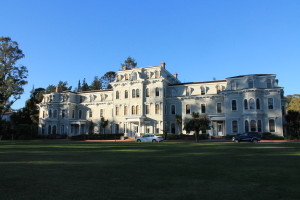
A large crowd peacefully demonstrated in Downtown Oakland in support of undocumented people and in protest of Donald Trump’s repeal of DACA.
Frank Ogawa Plaza in downtown Oakland filled with over 1,000 people protesting President Trump’s decision to end Deferred Action for Childhood Arrivals (DACA) on Saturday, Sept. 8.
On Sept. 5, Attorney General Jeff Sessions announced that the program would be repealed. In the days following the announcement, protests took place across the country, including San Francisco, Berkeley, and Oakland. DACA, which was established by former President Barrack Obama, protects undocumented immigrants who entered the country as minors.
Lucy Siale, organizer of the Oakland protest, has been taking part in protests and rallies for years, even though she is only 16 years old. Standing on a truck, she welcomed the cheering crowd, thanking them for showing up.
“By showing up we are saying no,” Siale said to the crowd. “We are saying no to Trump, we are saying no to exclusive immigration laws, we are saying no to banning people from coming here due to where they came from, due to the color of their skin, due to what they look like.”
Siale clarified that the rally and protest would remain peaceful, even though she believes that violence is sometimes necessary.
“This will not be a violent event,” Siale said. “I do not condemn violence, there is a time and a place for it and I respect that, however, this is not the time and the place.”
After welcoming the crowd and saying a few words, Siale made everyone aware that the front of the crowd was reserved for people with disabilities. She announced that when the march began, the people with disabilities would be at the front setting the pace. Siale advised all people interested in organizing rallies to remember accessibility issues.
“If you are organizing and you’re not being accessible, then you’re not being radical and you have to recognize that,” Siale said.
Nine more activists spoke after Siale, leading the cheering crowd in chants. Michael Mendoza spoke first, stating that he is “the proud son of a Mexican immigrant.”
“Keeping immigrants in fear of deportation prevents them from organizing against wage theft and other forms of exploitation,” Mendoza said. “Hard working immigrants are forced to live in fear while they give every bit of themselves to this country, and in return, they can barely survive here.”
The crowd exploded in cheers when Marlene Gutierrez took the microphone to speak, announcing that she is one of the 800,000 DACA recipients. She was brought into the country in 1998 from Jalisco, Mexico.
“America: no, I won’t apologize for breaking the law when I was brought here illegally,” Gutierrez said. “I was two years old.”
After making her speech in English, Gutierrez then made the same speech in Spanish.
“There are no borders to our dreams,” Gutierrez said. “We do not have a piece of paper saying we’re American, but it’s written all over our hearts and minds.”
After the rest of the speakers had their turns, the microphone was returned to Siale for her speech.
“White supremacists, klansmen, and nazis are not what make America great,” Siale said over cheers from the crowd. “DACA recipients make America great, undocumented immigrants make America great.”
Siale urged the white members of the crowd to start talking to their children about racism immediately.
“When I was four, a kid told me to go back to where I came from. I was four years old and didn’t even know how to spell my own name,” Siale said. “So don’t tell me that your little toddlers don’t need to hear about racism and don’t tell me that your preschooler is too young to learn about immigration laws.”
Once the speakers were finished, the crowd marched in a loop for approximately 45 minutes before returning to the plaza. The march remained peaceful, and marchers chanted and held signs as they walked. Upon returning to the plaza, people mingled and ate homemade food brought by speaker Kimberly Rojas.
Mills Junior Hannah Lu-Way attended the protest and march with a group of Mills students, and thought the protest was very effective.
“The rally and protest were really well organized and very peaceful,” Lu-Way said. “I think that this is a prime example of what activism should look like.”


